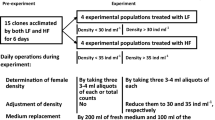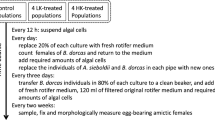Abstract
To test the hypothesis that non-consumptive predation pressures favor genotypes that have higher equilibrium densities or mictic ratios, we expose replicate populations of the rotifer Brachionus angularis to low (LK) and high (HK) concentrations of predator Asplanchna kairomones. Over 75 days (25 asexual generations) of selection, LK-treated populations have higher equilibrium densities and lower mictic ratios than the control populations. The opposite occurs for HK-treated populations. These results suggest that compared with the control, LK and HK select for genotypes with higher equilibrium densities and mictic ratios, respectively. Common garden bioassays reveal that in the absence of Asplanchna kairomones, populations with an LK selection history have a higher average intrinsic rate of population increase, and those with an HK selection history have a higher average mictic ratio than those with the control selection history, which suggest that adaptations to LK and HK increase average intrinsic rate of population increase and mictic ratio of prey populations, respectively. Increased intrinsic rate of population increase and mictic ratio can serve as strategies of offsetting mortality from predation and escaping the predator, and thus enable prey to survive low and high predation pressures, respectively.





Similar content being viewed by others
Data availability
All data generated or analyzed during this study are included in this published article.
References
Becks, L. & A. F. Agrawal, 2013. Higher rates of sex evolve under K-selection. Journal of Evolutionary Biology 26: 900–905.
Campillo, S., E. M. Garcia-Roger, M. J. Carmona & M. Serra, 2011. Local adaptation in rotifer populations. Evolutionary Ecology 25: 933–947.
Ciros-Pérez, J., M. J. Carmona & M. Serra, 2002. Resource competition and patterns of sexual reproduction in sympatric sibling rotifer species. Oecologia 131: 35–42.
Declerck, A. J. S. & S. Papakostas, 2017. Monogonont rotifers as model systems for the study of micro-evolutionary adaptation and its eco-evolutionary implications. Hydrobiologia 796: 131–144.
Dumont, H. J. & S. S. S. Sarma, 1995. Demography and population growth of Asplanchna girodi (Rotifera) as a function of prey (Anuraeopsis fissa) density. Hydrobiologia 306: 97–107.
Garland, T. & M. R. Rose, 2009. Experimental Evolution: Concepts, Methods, and Applications of Selection Experiments, University of California Press, Berkeley:
Gilbert, J. J., 1963. Mictic female production in the rotifer Brachionus calyciflorus. Journal of Experimental Zoology 153: 113–124.
Gilbert, J. J., 2013. The cost of predator-induced morphological defense in rotifers: experimental studies and synthesis. Journal of Plankton Research 35: 461–472.
Kawecki, T. J. & D. Ebert, 2004. Conceptual issues in local adaptation. Ecology Letters 7: 1225–1241.
Kubanek, J. & T. W. Snell, 2008. Chemical Communication Among Microbes, ASM Press, Washington:
Lahti, D. C., N. A. Johnson, B. C. Ajie, S. P. Otto, A. P. Hendry & D. T. Blumstein, 2009. Relaxed selection in the wild. Trends in Ecology and Evolution 24: 487–496.
Li, S. H., H. Zhu, Y. Z. Xia, M. J. Yu, K. S. Liu, Z. Y. Ye & Y. X. Chen, 1959. The mass culture of unicellular green algae. Acta Hydrobiologica Sinica 4: 462–472.
Losos, J. B., T. W. Schoener & D. A. Spiller, 2004. Predator-induced behaviour shifts and natural selection in field-experimental lizard populations. Nature 432: 505–508.
Pan, L., 2018. Plastical Changes and Rapid Microevolution of Brachionus Rotifers in Ecological and Morphological Traits in Response to Indirect Predation Pressures of Asplanchna Rotifers, Anhui Normal University, Wuhu:
Pan, L., Y. L. Xi, J. Gu, S. Jiang, H. Zhu & B. X. Zhang, 2018. Asplanchna-kairomone induces life history shifts in Brachionus angularis (Rotifera). Annales De Limnologie- International Journal of Limnology 54: 13.
Pianka, E. R., 1988. Evolutionary Ecology, 3rd ed. Harper & Row, New York:
R Core Team, 2014. R: A Language and Environment for Statistical Computing [available on internet at: http://www.R-project.org]. Accessed 18 September 2014.
Reznick, D. N., F. H. Shaw, F. H. Rodd & R. G. Shaw, 1997. Evaluation of the rate of evolution in natural populations of guppies (Poecilia reticulata). Science 275: 1934–1937.
Scheuerl, T. & C.-P. Stelzer, 2013. Patterns and dynamics of rapid local adaptation and sex in varying habitat types in rotifers. Ecology and Evolution 3: 4253–4264.
Smith, H. A. & T. W. Snell, 2012. Rapid evolution of sex frequency and dormancy as hydroperiod adaptations. Journal of Evolutionary Biology 25: 2501–2510.
Smith, H. A. & T. W. Snell, 2014. Differential evolution of lifespan and fecundity between asexual and sexual females in a benign environment. International Review of Hydrobiology 99: 117–124.
Snell, T. W., J. Kubanek, W. Carter, A. B. Payne, J. Kim, M. K. Hicks, et al., 2006. A protein signal triggers sexual reproduction in Brachionus plicatilis (Rotifera). Marine Biology 149: 763–773.
Stelzer, C., 2005. Evolution of rotifer life histories. Hydrobiologia 546: 335–346.
Stelzer, C. P. & T. W. Snell, 2003. Induction of sexual reproduction in Brachionus plicatilis (Monogononta, Rotifera) by a density-dependent chemical cue. Limnology & Oceanography 48: 939–943.
Stoks, R., L. Govaert, K. Pauwels, B. Jansen & L. De Meester, 2016. Resurrecting complexity: the interplay of plasticity and rapid evolution in the multiple trait response to strong changes in predation pressure in the water flea Daphnia magna. Ecology Letters 19: 180–190.
Tan, L. Z. & J. Gore, 2012. Slowly switching between environments facilitates reverse evolution in small populations. Evolution 66: 3144–3154.
Tarazona, E., E. M. García-Roger & M. J. Carmona, 2017. Experimental evolution of bet hedging in rotifer diapause traits as a response to environmental unpredictability. Oikos 126: 1162–1172.
Wan, Q., Z. Y. Huang, K. Zhang & Y. L. Xi, 2022. Evolution of a primary consumer in response to low and high food availability shapes life history traits and population demography. Hydrobiologia 849: 929–943.
Xi, Y. L., K. Q. Huang, L. Pan, H. Zhu, Y. L. Ge, X. L. Wen & X. L. Xiang, 2019. Rapid adaptation of Brachionus angularis (Rotifera) to invasion by Brachionus calyciflorus. Hydrobiologia 844: 31–42.
Xie, P., Y. L. Xi, X. L. Wen, J. Zhou, Y. Li, X. X. Niu, A. M. Wang & J. X. Wang, 2015. Responses of the spatio-temporal dynamics of rotifer community structure to the concentrations of N and P, and the effect of top-down in two lakes. Acta Ecologica Sinica 35: 4763–4776.
Zhang, Y., A. Zhou, Y. L. Xi, Q. Sun, L. F. Ning, P. Xie, X. L. Wen & X. L. Xiang, 2018. Temporal patterns and processes of genetic differentiation of the Brachionus calyciflorus (Rotifera) complex in a subtropical shallow lake. Hydrobiologia 807: 313–331.
Zhang, C., E. Goitom, K. Brans, L. De Meester & R. Stoks, 2022. Scared to evolve? Non-consumptive effects drive rapid adaptive evolution in a natural prey population. Proceeding of Royal Society B 289: 20220188.
Funding
This work was supported by the Natural Science Foundation of China (Grant Nos. 31971562, 31470015) and University Synergy Innovation Program of Anhui Province (Grant No. GXXT-2020-075).
Author information
Authors and Affiliations
Contributions
All authors contributed to the study conception and design. Material preparation, data collection and analysis were performed by LP and HZ. The first draft of the manuscript was written by LP and YLX, and all authors commented on previous versions of the manuscript. All authors read and approved the final manuscript.
Corresponding author
Ethics declarations
Conflict of interest
The authors have no conflicts of interest to declare that are relevant to the content of this article.
Ethical approval
The manuscript has not been submitted to more than one journal for simultaneous consideration, or published elsewhere in any form or language (partially or in full). The submitted work is original and presents all results of a single study clearly, honestly, and without fabrication, falsification or inappropriate data manipulation. All authors adhered to discipline-specific rules for acquiring and processing data. No data, text, or theories by others are presented as if they were the authors’ own. Proper acknowledgements to other works have been given. No material is verbatim copied.
Additional information
Handling editor: María Florencia Gutierrez
Publisher's Note
Springer Nature remains neutral with regard to jurisdictional claims in published maps and institutional affiliations.
Rights and permissions
Springer Nature or its licensor (e.g. a society or other partner) holds exclusive rights to this article under a publishing agreement with the author(s) or other rightsholder(s); author self-archiving of the accepted manuscript version of this article is solely governed by the terms of such publishing agreement and applicable law.
About this article
Cite this article
Pan, L., Zhu, H., Xi, YL. et al. Rapid adaptation of a rotifer prey population to non-consumptive predation pressures. Hydrobiologia 850, 4171–4179 (2023). https://doi.org/10.1007/s10750-023-05288-2
Received:
Revised:
Accepted:
Published:
Issue Date:
DOI: https://doi.org/10.1007/s10750-023-05288-2




